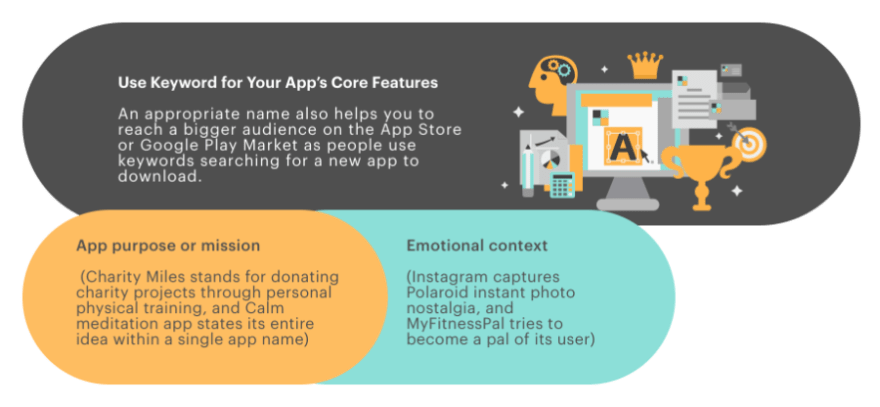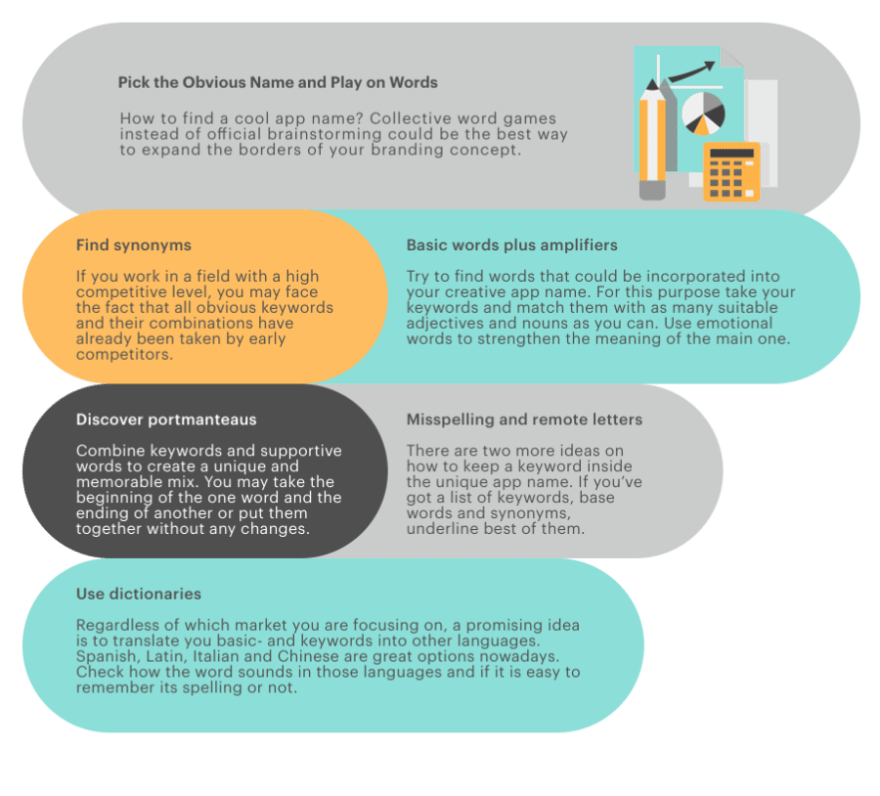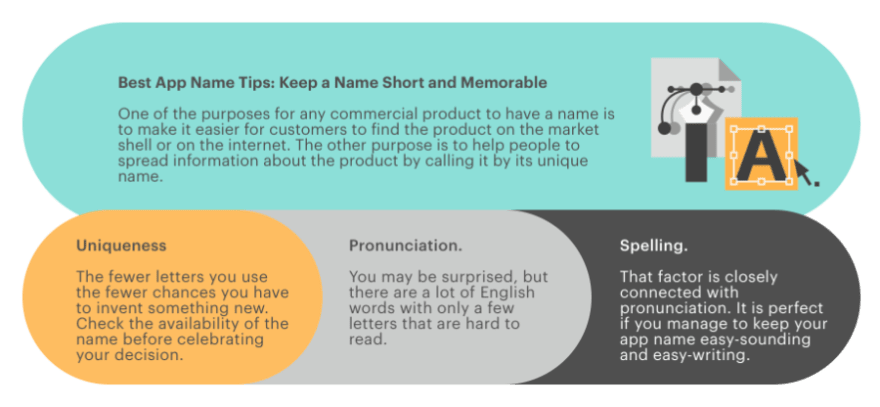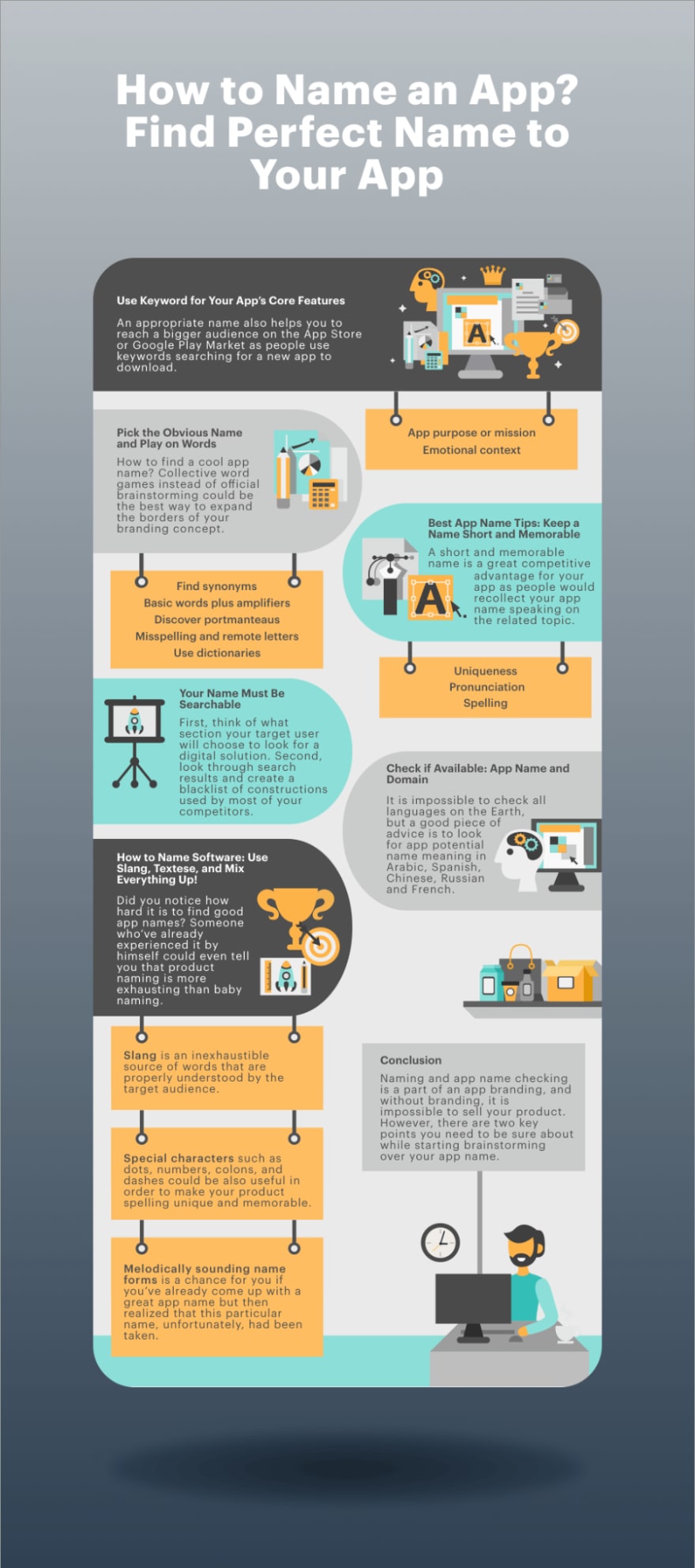Application naming is an essential part of its branding, marketers say, as the product name is aimed to evoke a brand feeling in the customer’s heart and leave it in their memory by a particular label.
The app name will follow the product wherever it will appear, so that is extremely important to choose the name that could help your product to work its way up and face fewer marketing troubles.
In this article, we are trying to find out how come that some names sounding like nonsense (take Google or Shazam) could overcome language and other barriers better than others. You will also find hundreds of useful tips on cool app naming here.
Use Keyword for Your App’s Core Features
Basically, why do you need app naming at all? As we’ve already mentioned, an app name, as well as an app logo, are the basis of its marketing strategy.
You need a laconic name because you probably need to be memorable in order to make potential users download your particular app but not one of your competitors.
An appropriate name also helps you to reach a bigger audience on the App Store or Google Play Market as people use keywords searching for a new app to download.
But what is even more important, an app name and logo is the first information you share with your potential user. That means that with a great app name you may immediately evoke positive feelings and start forming the desired attitude to your product and company in people’s mind.
It is important to understand that even a good app name is not a self-running instrument. It is designed to reflect the app market value. And the unique value of an app is its features. So don’t even try to name your product if you don’t know what features it has to perform. Remember: features first, app name next.
Clever app name should indicate what your app actually does. To begin with, take a paper and try to describe main app functions (or app idea) in short statements. When the work is done, underline the main words. Write down some common synonyms for those words and check what keywords your target audience may use to find the solution. Keywords searchers that could be useful for you are the following: WordTracker, KWFinder, and Soovle.
Example. Core feature – instant online messaging [media exchange, location sharing, socializing with friends, asking about news, video and audio calls, staying in touch with friends and colleagues]. Name – WhatsApp Messenger.
There is a lot of apps whose branding teams decided to stop already at this stage. Facebook Messenger, Google Maps, Evernote, Tasker, and SleepCycle are among them.
At the same time, generally, it is a bad idea to use keywords and description words only instead of the unique brand name. In that case, you may have a lot of competitors representing a similar product with a similar name which makes it difficult for a user not to mix up apps. Find app name playing on meanings.
Take into consideration that you also have an app’s description section where you could upload a text with necessary keywords. Don’t hesitate to take keywords as a basis for an app name, but try to add something to them to make them unique, or transform them totally to create cool names for apps.
Example. WeChat came from word chat, Duolingo came from words two and language, SoundCloud came from sound and cloud representing a streaming music platform for discovering unknown artists.
How to name an app and avoid mistakes? Although a keyword that describes your app features gives you a great advantage, there are other issues you may express in the app name to overcome competitors:
- App purpose or mission (Charity Miles stands for donating charity projects through personal physical training, and Calm meditation app states its entire idea within a single app name)
- Emotional context (Instagram captures Polaroid instant photo nostalgia, and MyFitnessPal tries to become a pal of its user)
Remember, that you may explain your app features or idea using not only nouns but also verbs, adjectives, prefixes, and suffixes. Words like best, app, pay, get, or go, as well as part of the words like -on or in- also works well as a supplement for the keywords.
Pick the Obvious Name and Play on Words
How to find a cool app name? Collective word games instead of official brainstorming could be the best way to expand the borders of your branding concept. They could also help you to find both app name and the insight unique market value of your product.
If an obvious keyword-based name is too simple for you or if it just doesn’t meet your expectation, continue the transformation. Keywords and words to express emotional background, your mission and the context is just the right point to start. The next stage is to create a memorable and easy to spell twist on them.
There are some promising word game ideas:
- Find synonyms. If you work in a field with a high competitive level, you may face the fact that all obvious keywords and their combinations have already been taken by early competitors. But wait! English is considered to be the richest language in the world and there are also more than 6,500 languages where you could borrow the word with the same meaning but different spelling. Use Thesaurus to find app name options. Examples: zero-waste family app Think Dirty doesn’t use a direct description of its features in the name.
- Basic words plus amplifiers. Try to find words that could be incorporated into your creative app name. For this purpose take your keywords and match them with as many suitable adjectives and nouns as you can. Use emotional words to strengthen the meaning of the main one. Example: finance tracking app may be secure (protected, defended, guarded, or shielded) and integrative (centralizing, centripetal, or combining). Repeat the procedure until you have found a perfect couple.
- Discover portmanteaus. Combine keywords and supportive words to create a unique and memorable mix. You may take the beginning of the one word and the ending of another or put them together without any changes and then name your application. Example: Pinterest stands for pin and interest, Instagram came from instant and telegram.
- Misspelling and remote letters. There are two more ideas on how to keep a keyword inside the unique app name. If you’ve got a list of keywords, base words and synonyms, underline best of them and try to spell them in a strange way. Example of clever app names: Netflix name came from the word net and flix which is a version of the word flicks meaning movies. You could also remove some letters from your name. It is better to reduce vowels that go after the main part of the word. Example: Tumblr instead of Tumbler.
- Use dictionaries. Regardless of which market you are focusing on, a promising idea is to translate you basic- and keywords into other languages. Spanish, Latin, Italian and Chinese are great options nowadays. Check how the word sounds in those languages and if it is easy to remember its spelling or not.
You could also pick some related words and popular phrases from international languages. That will make your product name extremely memorable. Examples of mobile app names: online social game Parchís uses the original Spanish national board game name while Alibaba Group, as well as an app, is named after the Arabic fairytale character Ali Baba.
Best App Name Tips: Keep a Name Short and Memorable
One of the purposes for any commercial product to have a name is to make it easier for customers to find the product on the market shell or on the internet. The other purpose is to help people to spread information about the product by calling it by its unique name. In other words, if your app name is not just understandable but also short and memorable, you will automatically increase your chances to gain a new audience.
A short and memorable name is a great competitive advantage for your app as people would recollect your app name speaking on the related topic.
Good names for social media apps are all like this.
But what does it mean to have a short name? Google Play Market, the App Store as well as other app downloading platforms have their own rules that regulate how many characters you may use to name your product. For Play Market, the number is 50, while the App Store allows using 30 characters at maximum.
Finally, only 12-characters-long app name will be seen in full on any screen, and 23-characters names appear properly on iPhones and iPads of all types.
Most apps’ names have less than 10 symbols and consist of two syllables. Examples – Facebook, Skype, SnapChat, Uber and Tinder. More about Uber app development read here.
At the same time, mobile app developers are used to adding to the app name words that could describe app functions such as LastPass Password Manager or Nova Launcher. They do not expect users to name their app by the full name but make it easier for them to find the app on the internet. It is also a great double shoot as apps like Nova Launcher could be reached both by searching Nova or just launcher.
Let’s summarize some key criteria to follow in order to keep your app name short and memorable:
- Uniqueness. The fewer letters you use the fewer chances you have to invent something new. Check the availability of the name before celebrating your decision.
- Pronunciation. You may be surprised, but there are a lot of English words with only a few letters that are hard to read. Giving a hard-to-pronounce name to your app you make it impossible for people to discuss your product orally. Good examples of app names that are easy to pronounce – Tinder and Tasker, bad examples – Bouncer and Dolphin Emulator.
- Spelling. That factor is closely connected with pronunciation. It is perfect if you manage to keep your app name easy-sounding and easy-writing. Mind, that it is hard for people to remember words of more than 6 characters if they had never seen them before. Use short neologisms or real words and try to avoid complicated sounds that do not exist in popular languages. Good examples – Uber and Tor, tough examples – Foursquare and Couchsurfing.
Your Name Must Be Searchable
In 2019, there are over 2 million apps available both on the App Store and Google Play. Even though the developers of those platforms are trying to improve the search engines and use self-learning technologies to show users the desired search results, it is still a problem to find a great app if it wasn’t named in a smart way.
To avoid being dropped to the very end of the searching list, try to predict or even plan the potential user journey.
First, think of what section your target user will choose to look for a digital solution. Second, look through search results and create a blacklist of constructions used by most of your competitors.
The best app names are searchable. 63% of mobile devices users discover new apps by searching the keywords. So, third, think of keywords and their combination that you couldn’t avoid in order to reach the target audience. You may use them if your competitors do not do the same too active, otherwise the audience will not see you on the first pages of the search results. By the way, Google optimization guidelines on app naming suggest using brand name plus key function naming formula.
Remember, that the app name is not the only place where you could put your keywords. Leave complicated constructions and long keywords for description which could be between 80 and 4,000 characters long.
If you are about to create an app for a highly competitive global market like social networking apps area or healthcare use keywords that could narrow down the audience.
Note that if your app name has a keyword, it will be shown in search results higher. The trick is how to avoid keywords used by every other competitor and to reach a specific audience. Example of mobile app names: VPNHub, Kiwi Browser, and Cookpad.
Check if Available: App Name and Domain
Regardless of how appealing your product name is, your efforts are wasted if the same name has been used by another company.
No platform allows to copy names and if your app name is just as the other one on the Google Play or the App Store it will be marked as the copy and the system will not proceed further uploading process.
The best strategy is to create an app name list and then check the availability of each with Google.
If you got stuck on app names stage, remember that there are a lot of free tools to help you with naming and domain checking. For example, Name Mesh is a popular generator to check if your name is not already taken as well as to develop name ideas from bold keywords. Online Name Generator and Dot-O-Mator are also a good option for those who got stuck on naming and could not find available app names.
An important obstacle you need to cope with is foreign languages and international language context. You may have found a perfect name that sounds catchy and is memorable for English-speaking audience, but what about people with another mother tongue? You can accidentally push an audience away from your product giving your product a name which sounds silly, offensive or vulgar in their languages.
It is impossible to check all languages on the Earth, but a good piece of advice is to look for app potential name meaning in Arabic, Spanish, Chinese, Russian and French.
Be especially careful with neologisms. If it is possible, gather a focus group and ask its representatives about associations that your product name recall in their mind. The results might be surprising.
Domain check is also an obligatory stage of app company name approving process. Having a product with a particular name you need to consider that people may not just look for it on the App Store but also search for it on Google. You may also have a web application that should be downloaded from the web page and a landing page with general information about your product, team, and links to both the App Store and Play Market.
If your desired domain name has been already taken, you are not likely to appear in the first position in Google. That means that promoting your product and its name you’ll share your played traffic with someone else.
How to Name Software: Use Slang, Textese, and Mix Everything Up!
Did you notice how hard it is to find good app names? Someone who’ve already experienced it by himself could even tell you that product naming is more exhausting than baby naming. For you not to become desperate and not to lose all initiative, energy, and creativity, we’ve collected several out-of-the-box ideas of how to develop an app name.
- Slang is an inexhaustible source of words that are properly understood by the target audience. Naming usually follows marketing research stage which means that before name brainstorming you’ve already gained a clear understanding of what your target user looks like (and – probably – how those people express themselves). Create a list of really trendy phrases and words and play on them. Example of using slang in naming – Yass and Kahoot! apps.
- Special characters such as dots, numbers, colons, and dashes could be also useful in order to make your product spelling unique and memorable. Examples – Booking.com and Kiwi.com. Mix capitals and regular letters to underline the hidden meaning of the name or put down numbers instead of words to make the make shorter. Examples of nice app name ideas – ooVoo, HERE WeGo, YouTube, FaceApp, 1Money, and 4 Share App. If your name is too short and you have enough space for creativity, try to double some letters to emphasize particular meaning and pronunciation. Examples – Badoo, Moovit and Busuu.
- Melodically sounding name forms is a chance for you if you’ve already come up with a great app name but then realized that this particular name, unfortunately, had been taken. It might be too late for word transformation with -ify (like Spotify), but -i, -y, -o and -a are still a nice idea. Examples – Yummly, Smarty, Foodie, and Phonto. Words like this are easy to remember and not hard to spell. You may also promote your product using songs or playing with words.
Conclusion
Naming and app name checking is a part of an app branding, and without branding, it is impossible to sell your product. However, there are two key points you need to be sure about while starting brainstorming over your app name.
The first is marketing research. You could not give an appealing name to your product if you hardly understand whom are you going to attract with it and why your main competitors are so adorable for their users. Research market, study your target group and call on a focus group if you’d like to do your best.
The second core point is the quality of your product. No matter how catchy your product is if its quality is low, your customers will not be satisfied with it. So, first of all, make sure that your product is good enough to be represented with a good name. Awesome sounding name has a chance to help you promote an app if only it really reflects app’s features, philosophy or user’s mindset. And the rest is about the creativity of your app name ideas!







Top comments (0)